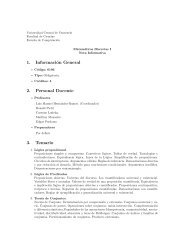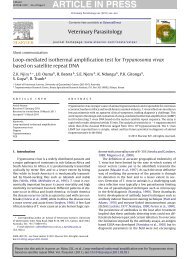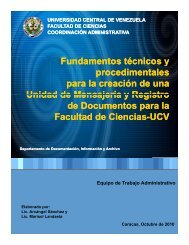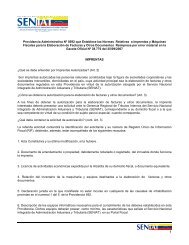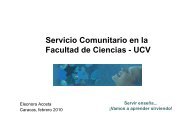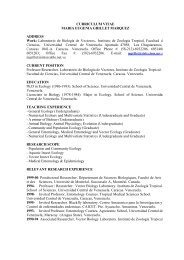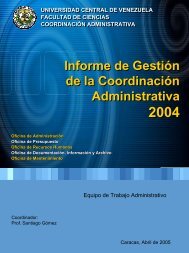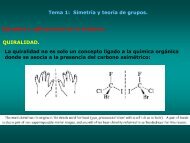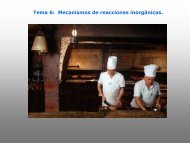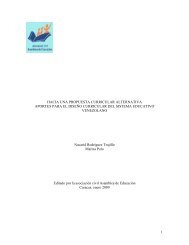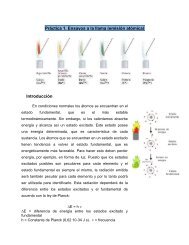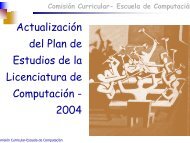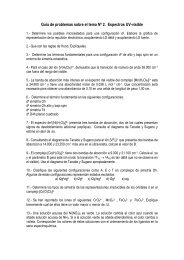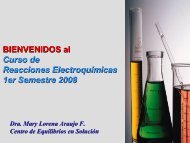Collecting and Preserving
Collecting and Preserving
Collecting and Preserving
- No tags were found...
Create successful ePaper yourself
Turn your PDF publications into a flip-book with our unique Google optimized e-Paper software.
collection <strong>and</strong> rearing container for insects emergingfrom cattle droppings. nCalif. Vector Views 22:43-46.__________ <strong>and</strong> others. 1978. <strong>Collecting</strong>, sampling, <strong>and</strong>rearing methods for aquatic insects. In Merritt, R. W.,<strong>and</strong> K. W. Cummins, An introduction to the aquaticinsects of North America. 441 pp. Kendall, Hunt,Dubuque, lowa. References on pp.13-28.Meyerdirk, D. E., <strong>and</strong> others. 1979. Evaluation of a trapfor the citrus blackfly, Aleurocanthus woglumi(Homoptera: Aleyrodidae). Can. Entomol. 111:1127-1129.Meyers, E. G. 1959. Mosquito collections by light traps atvarious heights above the ground. Proc. Calif. Mosq.Control Assoc. 27:61-63.Miller, T. A., <strong>and</strong> others. 1970. The influence of moonlight<strong>and</strong> other environmental factors on the abundanceof certain mosquito species in light-trapcollections in Thail<strong>and</strong>. J. Med. Entomol. 7:555-561.Minter, D. M. 1961. A modified Lumsden suction trap forbiting insects. Bull. Entomol. Res. 52:233-238.Mitchell, E. R., <strong>and</strong> others. 1972. Evaluation of cylindricalelectric grids as pheromone traps for loopers <strong>and</strong>tobacco hornworms. Environ. Entomol. 1:365-368.__________ <strong>and</strong> others. 1973. A portable cylindricalelectric grid trap. J. Econ. Entomol. 66:1232-1233.__________ <strong>and</strong> others. 1974. Cylindrical electric gridtraps: The influence of elevation, size <strong>and</strong> electrodespacing on captures of male cabbage loopers <strong>and</strong>tobacco hornworms. Environ. Entomol. 3:49-50.Mitchell, R. D., <strong>and</strong> D. R. Cook. 1952. The preservation<strong>and</strong> mounting of water-mites. Turtox News 30:169-172.Moericke, V. 1951. Eine farbefalle zür kontrolle des flugesvon blattlausen, insbesondere der pfirsichblattlaus,Myzodes persicae (Sulz.). Nachrichtenblatt derdeutschen pflanzenschutz dienst (Braunschweig) 3:23-24.Moericke, V. 1995. Über die lebensgewohnheiten dergeflugelten blattlause (Aphidina) under besondererberucksichtigung des verhaltens beim l<strong>and</strong>en.Zietschrift für angew<strong>and</strong>te entomologie 37: 29-91.Morel<strong>and</strong>, C. R. 1955. A wind frame for trapping insectsin flight. J. Econ. Entomol. 47:944.Morgan, C. V. G., <strong>and</strong> N. H. Anderson. 1958. Techniquesfor biological studies of tetranychid mites. Can.Entomol. 90:212-215.Morgan, N. C., <strong>and</strong> others. 1963. A comparison of thecatches of emerging aquatic insects in floating box<strong>and</strong> submerged funnel traps. J. Anim. Ecol. 32:203-219.Morgan, N. O., <strong>and</strong> E. C. Uebel. 1974. Efficacy of theAssateague insect trap in collecting mosquitoes <strong>and</strong>biting flies in a Maryl<strong>and</strong> salt marsh. Mosq. News34:196-199.Morrill, W. L. 1975. Plastic pitfall trap. Environ. Entomol.4:596.__________ <strong>and</strong> W. H. Whitcomb .1972. A trap for elateTechniques <strong>and</strong> Toolsimported fire ants. J. Econ. Entomol. 65:1194-1195.Morris, C. D., <strong>and</strong> G. R. DeFoliart. 1969. A comparison ofmosquito catches with miniature light traps <strong>and</strong> CO2-baited traps. Mosq. News 29:424-426.Morris, K. R. S. 1961. Effectiveness of traps in tsetsesurveys in the Liberian rain forest. Am. J. Trop. Med.<strong>and</strong> Hyg. 10:905-913.Mulhern, T. D. 1942. New Jersey mechanical trap formosquito surveys. N.J. Agr. Exp. Stn. Circ. 421:1-8Muma, M. H. 1975. Long term can trapping for populationanalyses of ground-surface, arid-l<strong>and</strong> arachnids.Fla. Entomol. 58:257-270. Includes bibliography ofcan <strong>and</strong> pitfall trapping.Mundie, J. H. 1956. Emergence traps for aquatic insects.Mitt. Int. Ver. Angew. Limnol. 7:113.__________ 1964. A sampler for catching emerginginsects <strong>and</strong> drifting materials in streams. Limnol.Oceanogr. 9:456-459.__________ 1966. Sampling emerging insects <strong>and</strong>drifting materials in deep flowing water. Gewaess.Abwaess. 41/42:159-162.__________ 1971. Insect emergence traps. InEdmondson, W. T., <strong>and</strong> G. G. Winberg, eds., A manualon methods for the assessment of secondary productivityin fresh waters. 358 pp. Blackwell Sci. Publ.(IBP H<strong>and</strong>b. 17), Oxford, Engl<strong>and</strong>. References on pp.80-93.Murphy, P. W., ed. 1962. Progress in soil zoology. 398 pp.Butterworth, London. Includes reference on stickytraps, pp. 226-227.Murphy, W. L. 1985. Procedures for removal of insectspecimens from sticky-trap material. Ann. Entomol.Soc. Am. 78:881.Murray, T. D., <strong>and</strong> W. N. Charles. 1975. A pneumatic grabfor obtaining large, undisturbed mud samples: Itsconstruction <strong>and</strong> some applications for measuring thegrowth of larvae <strong>and</strong> emergence of adultChironomidae. Freshwater Biol. 5:205-210.Nakagawa, S., <strong>and</strong> others. 1971. Trap-lure combinationsfor surveys of Mediterranean fruit flies in Hawaii. J.Econ. Entomol. 64:1211-1213.__________ <strong>and</strong> others. 1975. Gallon plastic tub, asubstitute for the McPhail trap. J. Econ. Entomol.68:405-406.Nantung Institute of Agriculture. 1975. Effects of lighttraps equipped with two lamps on capture of insects.[In Chinese, with English summary.] Acta Entomol.Sinica 18:289-294.Nation, J. L. 1983. A new method usinghexamethlydisilazane for preparation of soft insecttissues for scanning electron microscopy. StainTechnology. 58: 347-351.Neal, J. W., Jr., ed. 1979. Pheromones of the Sesiidae(formerly Aegeriidae). U.S. Dept. Agr., Agr. Res.Serv., ARK-NE-6, 83 pp. Proceedings of a symposium,including trapping <strong>and</strong> perspective of pheromoneresearch.61



